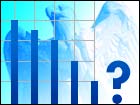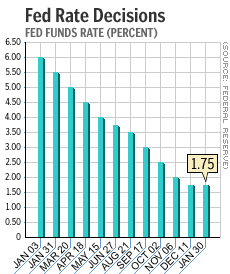
NEW YORK (CNN/Money) - Federal Reserve policy makers met Tuesday to discuss what action, if any, they should take in light of a recovering U.S. economy, and they were widely expected to leave rates interest rates alone and say the risks to the economy are evenly balanced between a risk of weakness and a risk of inflation.
To help the U.S. economy recover from a recession that possibly began in March 2001, the Fed cut rates 11 times in 2001, a record for a calendar year, bringing the central bank's target for the federal funds rate, an overnight bank lending rate, to 1.75 percent, the lowest level in 40 years.
But the Fed left rates alone at its first meeting in 2002, and Chairman Alan Greenspan has lately declared the recession over. As a result, many economists expect the Fed, at its policy meeting that began Tuesday morning, to again leave rates alone and, in the statement accompanying its decision, finally tone back the red-alert rate-cutting bias it's held since December 2000.
The Fed's decision and accompanying statement are due at 2:15 p.m. ET. U.S. stock prices rose slightly in morning trading as investors waited for the Fed's decision, while Treasury bond prices fell.
"The Fed is likely to make no change in its rate policy because it still see risks in the economic outlook, but I suspect it will remove its bias towards easing," Richard Rippe, chief economist at Prudential Financial, told CNNfn's Market Call program. "Now that recovery is underway, the Fed will probably tell us the risks are a little more evenly split between weakness and inflation."

The Fed's stated goal is to foster economic growth and contain inflation at the same time, cutting short-term interest rates to fight the former and raising rates to defend against the latter. After policy meetings, it issues a short statement, announcing its decision on rates and identifying the risks that face the economy, either of economic weakness or of inflation. Since December 2000, it's seen only a risk of economic weakness. Of 24 Wall Street economists surveyed Friday by Reuters, 19 thought the Fed would adopt a neutral stance on Tuesday, saying the risks to the economy are balanced between weakness and inflation.
The implied yield on the federal funds futures contract has been an accurate gauge lately of what the Fed's rate target will be. As of Friday, traders were betting that the Fed would leave rates alone Tuesday, but also that a quarter-percentage-point rate hike was almost certain by the time the central bank meets in May. Further, traders expect short-term rates to be as high as 3 percent by the end of the year, according to the fed funds futures contracts.
The Fed, of course, is not governed by what investors think, and the central bank could raise rates or leave them alone as economic data and other developments dictate.
"They're doctors. If the patient is fine, they'll do nothing," said Delos Smith, chief economist at the Conference Board. "If they feel the economy has trouble spots, they will try to deal with it, and the medicine is raising interest rates."
Inflation or not?
For several months, wholesale and consumer prices have been in check, driven lower by a global economic slowdown, relatively low oil prices and other factors. Some economists think prices are still so low and economic activity so weak that it will take at least several months before inflation becomes a possible threat. These analysts say investors in the bond market are overestimating the threat of inflation, and the case for the Fed to raise rates.
Bolstering this view, last Wednesday's data on February retail sales were weaker than expected, disappointing investors and highlighting Greenspan's oft-repeated warning that the recovery will be relatively weak, in part because consumers have already spent so much that an acceleration of spending is unlikely. If his outlook is correct -- a real possibility if the unemployment rate rises to 6 percent this year, as many economists expect -- then the Fed likely will be inclined to leave rates lower much longer, rather than risk squelching a recovery before it even gets started.
"The markets are telling us the Fed is likely to start raising rates in early May and again at the end of June and probably more aggressively in the second half of the year. The Fed has been trying to calm those expectations," said Scott Brown, chief economist at Raymond James & Associates. "Rates ought to stay low for quite some time."
The Fed typically cuts short-term interest rates during periods of weakness in a bid to spur spending and bolster the economy, and raises them when it wants to make money more expensive and ward off a possible pickup in inflation.
| |
 Related links
Related links
| |
| | |
| | |
|
But the economy is undoubtedly picking up steam, as demonstrated by recent reports showing improving consumer sentiment, the first increase in business inventories in a year, a stabilizing labor market and the end of a 19-month recession in the manufacturing sector.
The Organization of the Petroleum Exporting Countries (OPEC) on Friday decided to leave oil production alone, despite the growing possibility of military action in Iraq, raising the likelihood that oil prices will rise and put upward pressure on other prices. That pressure could be mitigated by Russia, which is not a part of OPEC, and would be free to raise production if prices get too high.
Some economists point out that, while prices for wholesale goods have been tame, prices for services have been consistently high, which could eventually push consumer prices upward.
"While we can be somewhat blase about goods [prices], at least for a little while longer, we cannot conclude that retail inflation is anywhere near under control," said Joel Naroff, chief economist at Naroff Economic Advisors.

|

